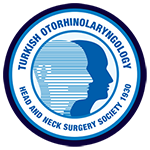ABSTRACT
Objectives:
Dacryocystorhinostomy (DCR) is a surgical procedure where an alternative pathway is created to drain an obstructed lacrimal system into the nasal cavity. This can be accomplished externally or via endonasal approach in which the lacrimal sac is connected directly to the nose by removing the layers of bone and mucosa to separate these two structures.
Methods:
The surgical outcome of endoscopic endonasal DCR was reviewed minimum 5 maximum 23 months in 22 cases with nasolacrimal duct stenosis. Pope-Merocel® and primer silicon tube was applied for preventing restenosis.
Results:
Stenosis occurred at 5 (%31.2) cases with Pope-Merocel® and silicon tube was inserted at a second stage. There is not any stenosis at the primer or secondary silicon tube inserted cases.
Conclusion:
The success rate of endoscopic DCR has become comparable with that of traditional external DCR. Advantages of the endonasal approach are excellent visualization, lack of incisional scar, less time consuming, saving the medial palpebral ligament and the lacrimal pomp mechanism. If necessary additional management of intranasal pathology can be performed simultaneously.
ÖZET
Amaç:
Dakriyosistorinostomi (DSR), tıkanık lakrimal sistemin burun içine alternatif bir yol açılarak drene edilmesidir. Bu işlem eksternal ya da endonazal yolla, lakrimal keseden buruna direkt bağlantı açılacak şekilde, bu iki yapıyı birbirinden ayıran kemik ve mukoza tabakası alınarak yapılabilir.
Yöntem:
Nazolakrimal kanalı tıkalı 22 hastanın endoskopik DSR sonuçları en az 5 en çok 23 ay incelendi. Restenoz riskine karşı Pope-Merocel® ve silikon tüp uygulandı.
Bulgular:
Pope-Merocel®'li hastalardan 5'inde (%31.2) tekrar ste-noz gelişmiş olup, bunlara ikinci bir seansta slikon tüp uygulandı. Primer ve sekonder tüp uygulanan hastalarda halen stenoza rastlanmadı.
Sonuç:
Endoskopik DSR'nin başarı oranı geleneksel eksternal DSR ile karşılaştırılabilir seviyeye gelmiştir. Endonazal endoskopik yaklaşımın avantajları; mükemmel görüş, insizyon skarının olmaması, daha az zaman gerektirmesi, mediyal palpebral ligamanın ve lakrimal pompa mekanizmasının korunmasıdır. Eğer gerekirse eş zamanlı olarak intranazal patolojilerin tedavisi de yapılabilmektedir.



